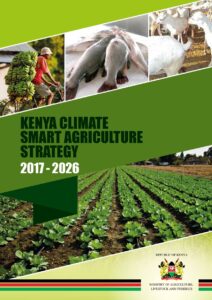

KENYA CLIMATE SMART AGRICULTURE STRATEGY 2017 -2026
Climate change is real and has become an impediment to sustainable development globally. Climate change will have a range of positive and negative impacts in agriculture depending on the regions of the world. The negative impacts are expected to be more adverse in developing countries, particularly those in sub-Saharan Africa such as Kenya which has … Continued
Summary
Climate change is real and has become an impediment to sustainable development globally. Climate change will have a range of positive and negative impacts in agriculture depending on the regions of the world. The negative impacts are expected to be more adverse in developing countries, particularly those in sub-Saharan Africa such as Kenya which has experienced increasing temperatures from 1960’s coupled with increased frequency and intensity of extreme weather events such as El Niño and La Niña. Effects of the negative impacts will include declining agricultural productivity and loss of crops, livestock, fish and investments in agriculture due to changing temperatures and precipitation regimes and increased frequency and intensity of extreme weather events. Further, fisheries and aquaculture are affected through acidification of the water bodies, changes in water temperatures and circulation patterns which alter the physico-chemical properties of the fish habitats and ultimately the productivity. Agriculture is not only impacted upon by climate change but also contributes to the problem. The country’s agriculture is predominantly rain-fed and therefore vulnerable to climate change particularly changes in temperature regimes and precipitation patterns, and extreme weather events. This leads to, among others, unsustainable land and agricultural water management. Kenya’s greenhouse gas (GHG) emissions were estimated to be 73 million tons of carbon dioxide equivalent (MtCO2 e) in 2010 and are expected to rise to 143 MtCO2 e in 2030 unless appropriate mitigation actions are taken. Agriculture is the largest source of GHG emissions; it was responsible for one-third of Kenya’s total emissions in 2010. Agricultural emissions are likely to increase from 20 MtCO2 e in 2010 to 27 MtCO2 e by 2030, largely driven by livestock methane emissions and land use change, which account for 90% of agriculture emissions and 30% of overall national emissions.

